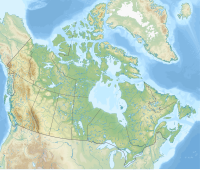| Wenkchemna Peak | |
|---|---|
 Wenkchemna Peak | |
| Highest point | |
| Elevation | 3,206 m (10,518 ft) [1] [a] |
| Prominence | 16 m (52 ft) [1] |
| Parent peak | Mount Hungabee (3492 m) [1] |
| Listing | |
| Coordinates | 51°19′43″N116°16′35″W / 51.3286111°N 116.2763889°W [4] |
| Geography | |
| Country | Canada |
| Provinces | Alberta and British Columbia |
| District | Kootenay Land District [5] |
| Protected areas | |
| Parent range | Bow Range [4] [1] |
| Topo map | NTS 82N8 Lake Louise [4] |
| Geology | |
| Rock type | Sedimentary rock |
| Climbing | |
| First ascent | 1923 F.C. Bell, A.W. Drinnan, H. Herriot, T.B. Moffat, R. Neil, E. Thompson, R. Williams, Christian Hasler Jr. [2] [1] |
Wenkchemna Peak is located on the SE ridge coming off of Mount Hungabee on the border of Alberta and British Columbia. It was named in 1894 by Samuel E. S. Allen for the Stoney Indian word for ten. [2] [1] [5]
Contents
Wenkchemna is the 10th peak in The Valley of the Ten Peaks, as they are normally numbered (left to right as seen from Moraine Lake). It is an extension into the valley of the ridge formed by Mount Hungabee and Ringrose Peaks.


